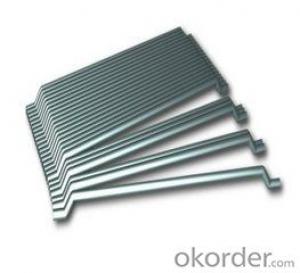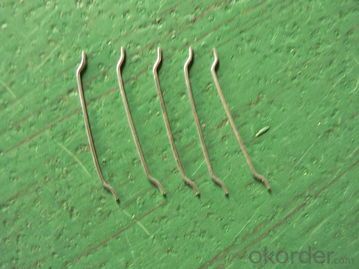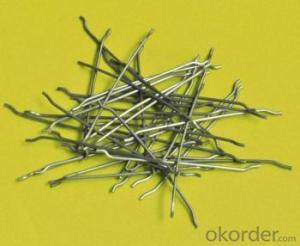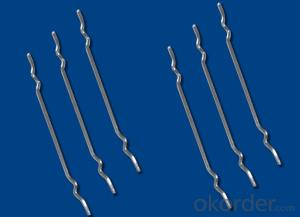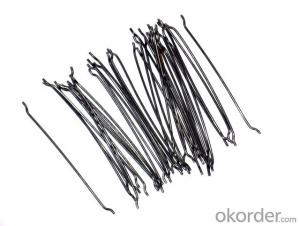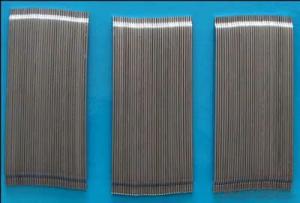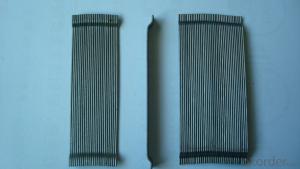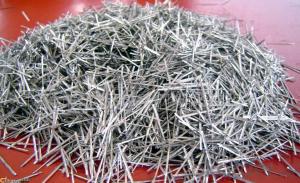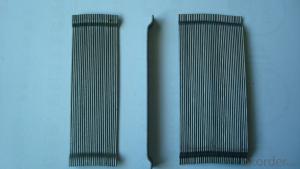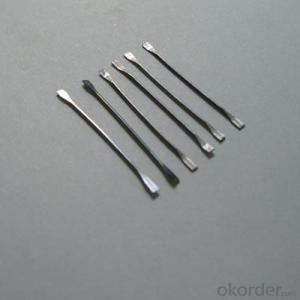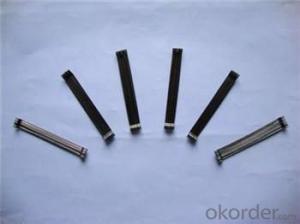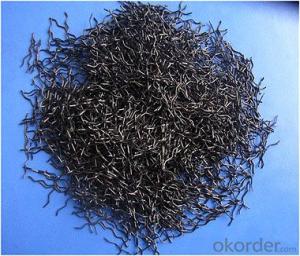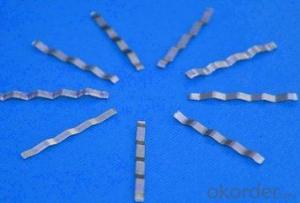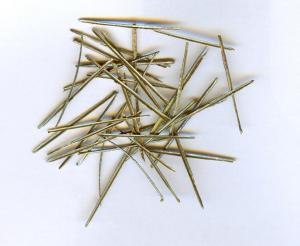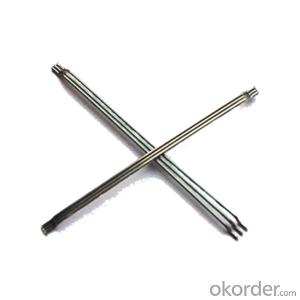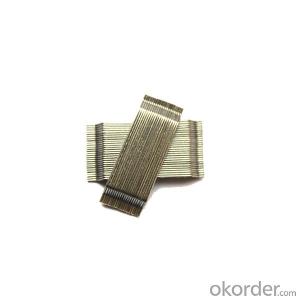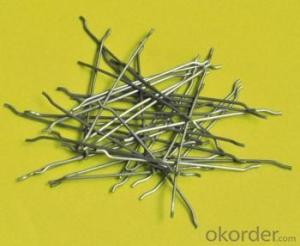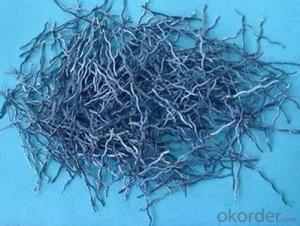Melt Extract Stainless Steel Fiber Wavy for Construction and Concrete
- Loading Port:
- Tianjin
- Payment Terms:
- TT OR LC
- Min Order Qty:
- 5000 kg
- Supply Capability:
- 250000 kg/month
OKorder Service Pledge
OKorder Financial Service
You Might Also Like
Quick Details
material: steel wire
shape: corrugated round fiber
appearance: clean and bright
usage: construction and concrete
Place of Origin: Shandong, China (Mainland)
Model Number: steel fiber
Product features
steel iber for concrete reinforcement ,it`s widely used in buildings ,bridges ,thin roof engineering ,highway etc
cncrete steel iber is specificially designed to enhance concrete in its hardened state ,the uniform distribution of steel fibers throughout the concrete greatly improves concrete bonding and tensile strength ,additionally it provides exceptional load stability and durability ,as reliable and efficient concrete reinforcement material .
it is widely used in buildings ,bridges ,thin roof engineering ,highway etc.
Specifications
Length :20-60mm
Diameter :0.5-1.2
Tensile strength:600Mpa-900Mpa
Appearance :clear and bright steel wire
Style :corrugated round fiber
Picture
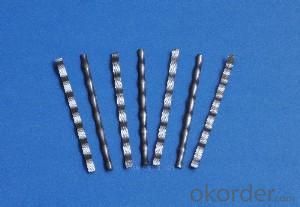
FAQ
we can produce any type steel fiber and of course we can make production according to your requirement
we have specilize in this field for almost 10 years ,with good quality and competitive price
- Q: Can melt extract stainless steel fiber be used in shotcrete tunnel lining applications?
- Yes, melt extract stainless steel fiber can be used in shotcrete tunnel lining applications. Stainless steel fibers are commonly used in shotcrete applications due to their high tensile strength, corrosion resistance, and durability. These fibers help to improve the overall performance and longevity of the shotcrete lining by enhancing its crack resistance, ductility, and flexural strength. The unique properties of melt extract stainless steel fibers make them suitable for use in tunnel linings where high-strength and long-term durability are essential.
- Q: What is the effect of melt extract stainless steel fiber on the fire resistance of concrete?
- The addition of melt extract stainless steel fiber to concrete has a significant effect on the fire resistance of the material. Stainless steel fibers are known for their high melting point and excellent heat resistance properties. When incorporated into concrete, these fibers provide enhanced fire resistance by improving the material's overall thermal conductivity and reducing the risk of spalling, cracking, or structural failure during a fire event. The stainless steel fibers act as reinforcement within the concrete matrix, increasing its tensile strength and preventing the propagation of cracks caused by thermal expansion and contraction. This reinforcement effect allows the concrete to maintain its structural integrity for a longer period of time under high temperatures. The presence of stainless steel fibers also helps to minimize the loss of strength and stiffness in concrete exposed to fire. This is achieved through the fibers' ability to withstand high temperatures without undergoing significant deformation or degradation. As a result, the concrete retains its load-bearing capacity and can better resist the effects of fire-induced stress. Furthermore, the use of melt extract stainless steel fibers can reduce the risk of spalling, which is a common phenomenon in concrete when exposed to fire. Spalling occurs when the outer layer of concrete is subjected to rapid heating, causing the evaporation of water trapped within the pores. The resulting steam pressure can lead to explosive spalling and loss of structural integrity. The steel fibers help to mitigate this by providing a reinforcement network that holds the concrete together, preventing the rapid release of steam and minimizing spalling. In summary, the incorporation of melt extract stainless steel fiber in concrete significantly improves its fire resistance by enhancing thermal conductivity, reducing spalling, increasing tensile strength, and maintaining structural integrity. These beneficial effects make it an effective solution for enhancing the fire performance of concrete structures, especially in high-risk fire scenarios.
- Q: What is the effect of melt extract stainless steel fiber on the crack width in shotcrete?
- The use of melt extract stainless steel fiber in shotcrete can effectively reduce crack width by enhancing the tensile strength and ductility of the material. The fibers act as reinforcement, distributing the stress more evenly, and preventing the propagation of cracks. This results in improved crack resistance and overall durability of the shotcrete structure.
- Q: What is the difference between melt extract stainless steel fiber and other types of steel fibers?
- Melt extract stainless steel fiber, also known as melt extract steel fiber, is a type of steel fiber that is made by melting stainless steel and then rapidly extracting it into fine fibers. This process results in fibers that have unique properties and characteristics compared to other types of steel fibers. One key difference between melt extract stainless steel fiber and other types of steel fibers is its enhanced corrosion resistance. Stainless steel is known for its ability to resist corrosion and oxidation, making melt extract stainless steel fibers highly resistant to rust and degradation over time. This makes them suitable for use in environments where exposure to moisture, chemicals, or other corrosive substances is common. Another difference is the increased tensile strength of melt extract stainless steel fibers. The rapid extraction process helps to align the steel molecules, resulting in fibers that are stronger and more durable compared to other types of steel fibers. This improved tensile strength makes melt extract stainless steel fibers ideal for reinforcing concrete or other materials that require high strength and durability. Furthermore, melt extract stainless steel fibers also exhibit excellent thermal conductivity and electrical conductivity. This property makes them suitable for applications where heat or electricity needs to be transferred efficiently. For example, melt extract stainless steel fibers can be used in heating elements, electromagnetic shielding, or as conductive reinforcement in composites. Lastly, melt extract stainless steel fibers have a smoother surface compared to other steel fibers. This smooth surface allows for better bonding with the surrounding matrix, such as concrete or resin, leading to improved load transfer and enhanced overall performance. The smoothness of the fibers also reduces the likelihood of fiber pull-out or fiber breakage, further increasing their effectiveness as reinforcement materials. In summary, melt extract stainless steel fibers differ from other types of steel fibers due to their enhanced corrosion resistance, increased tensile strength, excellent thermal and electrical conductivity, and smoother surface. These unique properties make them a preferred choice for various applications that require high-performance reinforcement materials.
- Q: Can melt extract stainless steel fiber be used in lightweight concrete blocks or panels?
- Melt extract stainless steel fiber is applicable for utilization in lightweight concrete blocks or panels. Lightweight concrete blocks or panels are commonly produced using lightweight aggregates and diminishing the density of the concrete mixture. The inclusion of stainless steel fibers can heighten the mechanical characteristics of the lightweight concrete, such as augmenting tensile and flexural strength, lessening cracking, and enhancing the overall durability of the blocks or panels. Stainless steel fibers possess high tensile strength, corrosion resistance, and exceptional bonding properties with concrete, making them ideal for reinforcing lightweight concrete structures. Moreover, the incorporation of stainless steel fibers can also furnish improved resistance to fire, impact, and fatigue. Consequently, melt extract stainless steel fiber serves as an appropriate choice for reinforcing lightweight concrete blocks or panels.
- Q: How does melt extract stainless steel fiber improve the resistance to rutting in asphalt mixtures?
- The resistance to rutting in asphalt mixtures is improved by the presence of melt extract stainless steel fiber, which operates through various key mechanisms. Firstly, the tensile strength and toughness of the asphalt mixture are enhanced by the addition of stainless steel fibers. This increase in strength and toughness aids in the even distribution of the load across the surface of the pavement, thereby reducing the likelihood of rutting. Secondly, the stainless steel fibers function as reinforcement within the asphalt mix, preventing the formation and propagation of cracks. By doing so, these fibers preserve the integrity and stability of the asphalt pavement, effectively preventing the formation of ruts. Moreover, the inclusion of stainless steel fibers in the asphalt mix also boosts its resistance to deformation and the ability to recover from deformation. These fibers provide additional support and resistance against repeated loading and heavy traffic, ultimately reducing permanent deformation and rutting. Furthermore, the presence of stainless steel fibers enhances the resistance of the asphalt pavement to moisture-induced damage. They serve to hinder the penetration of water into the pavement, thus minimizing the risk of moisture-related distresses such as rutting. In summary, the utilization of melt extract stainless steel fiber in asphalt mixtures improves the resistance to rutting by enhancing the tensile strength, toughness, crack resistance, deformation resistance, and moisture resistance of the pavement. This results in a more robust and long-lasting pavement surface that can withstand heavy traffic loads without succumbing to rutting.
- Q: How does melt extract stainless steel fiber improve the fire resistance of concrete?
- The fire resistance of concrete is improved by the presence of melt extract stainless steel fiber, which serves as a reinforcement material. When exposed to high temperatures during a fire, the stainless steel fiber reinforces the concrete, enhancing its structural integrity by providing extra strength and stability. The stainless steel fiber is capable of withstanding high temperatures without melting or losing its mechanical properties. As a result, it effectively distributes stress and load within the concrete, preventing cracks and fractures that could compromise the material's structural integrity. Moreover, the stainless steel fiber in the concrete helps delay the occurrence of spalling. Spalling is when the surface layers of concrete break apart and detach due to the rapid expansion of trapped moisture within the material when exposed to high temperatures. By reinforcing the concrete, the stainless steel fiber retains moisture and hinders its rapid release, thereby reducing the risk of spalling. Additionally, the stainless steel fiber acts as a heat sink, absorbing and dissipating heat more efficiently than the surrounding concrete. This capability aids in reducing the overall temperature increase of the material during a fire. By diminishing the temperature rise, the stainless steel fiber can minimize thermal expansion and contraction, decreasing the chances of cracks and preserving the concrete's structural integrity. In conclusion, incorporating melt extract stainless steel fiber into concrete greatly enhances its fire resistance by bolstering its structural strength, reducing spalling, and minimizing temperature rise. This makes it a highly effective solution for enhancing the fire safety of concrete structures in various applications, such as buildings, tunnels, and industrial facilities.
- Q: Can melt extract stainless steel fiber be added to cementitious grouts?
- It is possible to incorporate melt extract stainless steel fiber into cementitious grouts. These fibers are often utilized as a reinforcement material in cementitious products to boost their mechanical properties. By introducing stainless steel fibers into grouts, one can enhance their tensile strength, flexural strength, and resistance to cracks. Furthermore, the inclusion of stainless steel fibers aids in managing shrinkage and preventing cracking. All in all, the integration of melt extract stainless steel fibers into cementitious grouts can elevate their effectiveness and longevity.
- Q: How does melt extract stainless steel fiber affect the workability of self-consolidating concrete?
- Melt extract stainless steel fiber can have a significant impact on the workability of self-consolidating concrete. This type of fiber, which is typically added to the concrete mix, enhances the overall performance and durability of the concrete. One of the key ways in which melt extract stainless steel fiber affects workability is by improving the flow characteristics of the concrete. Self-consolidating concrete is known for its ability to flow and fill complex forms without the need for mechanical vibration. The addition of stainless steel fibers helps maintain the required viscosity and flowability of the concrete while also preventing segregation and bleeding. Moreover, the presence of stainless steel fibers in the concrete mix improves the cohesion and stability of the mixture. This means that the concrete will have enhanced resistance to segregation and settling during placement and transportation. The fibers act as reinforcements, improving the overall structural integrity of the concrete. Additionally, melt extract stainless steel fibers also contribute to the crack resistance and toughness of self-consolidating concrete. The fibers help distribute the stress and load across the concrete matrix, reducing the likelihood of cracking and enhancing its ability to withstand external forces. This is particularly important in applications where the concrete may be subjected to high loads or harsh environments. However, it is worth noting that the workability of self-consolidating concrete can be affected by the dosage and aspect ratio of the stainless steel fibers. The optimal dosage and aspect ratio should be carefully determined to ensure that the desired workability is achieved without compromising the overall performance of the concrete. In conclusion, melt extract stainless steel fiber positively impacts the workability of self-consolidating concrete by improving its flow characteristics, cohesion, stability, crack resistance, and toughness. By carefully adjusting the dosage and aspect ratio of the fibers, the desired workability can be achieved while enhancing the overall performance and durability of the concrete.
- Q: Can melt extract stainless steel fiber be used in heavy-duty industrial pavements?
- Yes, melt extract stainless steel fiber can be used in heavy-duty industrial pavements. Stainless steel fibers are known for their high tensile strength, corrosion resistance, and durability, making them suitable for demanding applications such as heavy-duty industrial pavements. These fibers can enhance the concrete's mechanical properties, such as crack resistance, impact resistance, and abrasion resistance, thereby improving the overall performance and longevity of the pavement. Additionally, the use of stainless steel fibers can also reduce the need for traditional reinforcement methods, such as steel bars or mesh, leading to cost savings and easier construction. Overall, melt extract stainless steel fiber is a viable option for heavy-duty industrial pavements due to its exceptional properties and benefits.
Send your message to us
Melt Extract Stainless Steel Fiber Wavy for Construction and Concrete
- Loading Port:
- Tianjin
- Payment Terms:
- TT OR LC
- Min Order Qty:
- 5000 kg
- Supply Capability:
- 250000 kg/month
OKorder Service Pledge
OKorder Financial Service
Similar products
Hot products
Hot Searches
Related keywords
